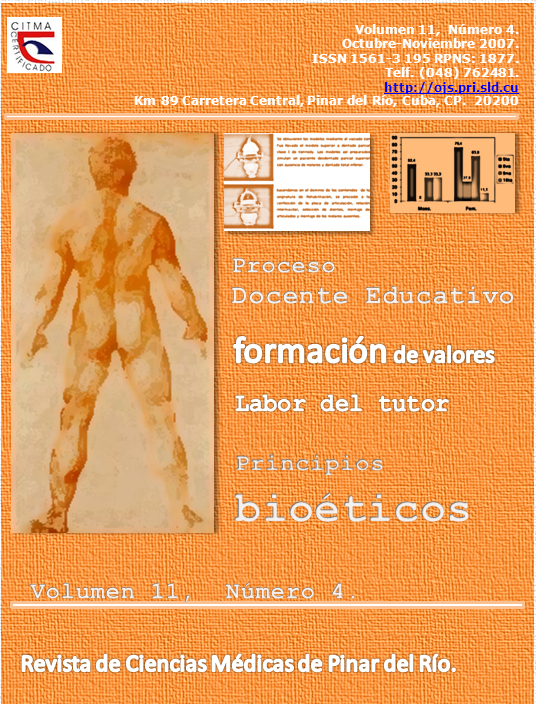Evaluación de los resultados de la especialidad de estomatología general integral. Pinar del Río. 2006 / Assessment of the results in the specialty of Comprehensive Dentistry. Pinar del Río, 2006
Abstract
La evaluación es la etapa del proceso educacional que comprueba de forma sistemática los objetivos que se han especificado con antelación. Teniendo en cuenta estos preceptos se realizó un estudio descriptivo longitudinal de las evaluaciones teórico- prácticas de la especialidad de Estomatología General Integral, con el objetivo de evaluar los resultados y compararlos en sus diferentes etapas y modalidades. La muestra estuvo representada por todos los graduados de EGI de Pinar del Río en Diciembre de 2006, para ello se utilizó el método de análisis porcentual. Los resultados muestran un predominio de la evaluación de Excelente en 1er Año, para un 97.1%, en el 2do Año de 96.9% y en el examen práctico del 1er Año, 93.6%. La evaluación de Bien predominó en el examen teórico de 2do y 1er Año, con un 47.4% y 38.7%, respectivamente y en el examen práctico de 2do Año, 33.8%. La evaluación de Regular predominó en el examen teórico estatal y en el de 2do Año un 66.1% y 40.6% respectivamente. Los Desaprobados prevalecieron en el examen teórico de 1er Año y examen Estatal, 11.9% y 3%, respectivamente. Después de analizar los resultados concluimos que, las principales dificultades estuvieron en los resultados de los exámenes teóricos, los cuales no se corresponden con la labor de curso, la mayoría de los graduados terminaron con una Evaluación de Bien.
Palabras clave: EVALUACIÓN EDUCACIONAL, ODONTOLOGÍA, INTERNADO Y RESIDENCIA.
ABSTRACT
The evaluatin is a stage in the educational process that must check systematically the achievement of the objectives, taking into account this action. A descriptive, longitudinal study about the theoretical and practical evolution of the specialty (comprehensive dentistry) was conducted, aimed at assessing the results and compare them with the diffeent stages and modalities. The sample was formed by all graduates in the specialty (December 2006) in Pinar del río. The percentage analysis was used to record the results. The evaluation of Excellent prevailed in the first academic year (97.1%), en the second year (96.9%), in the practical examination of the 1st. year (93.6%). The evaluation of Good prevailed in the theoretical tests of the 1st. and 2nd. Years (47.4% and 38.7%) respectively. Practical tests of the 2nd. Year showed 33.8 %. The evaluation of Fair prevailed in the theoretical state examination and in the 2nd. Year (66.1%) and (40.6%) in the same order. The category of Disapprove in theoretical state examinationshowed in the 1st. year 11.9% and 3%. After analyzing the results, the main difficulties appeared in theoretical examinations, not having correspondence with the activity developed along the course, the majority of the graduates finished with an evaluation of Good.
Key words: EDUCATIONAL EVALUATION, DENTISTRY MAJOR, INTERNSHIP AND RESIDENCE.
Downloads
How to Cite
Issue
Section
License
Authors who have publications with this journal agree to the following terms: Authors will retain their copyrights and grant the journal the right of first publication of their work, which will be publication of their work, which will be simultaneously subject to the Creative Commons Attribution License (CC-BY-NC 4.0) that allows third parties to share the work as long as its author and first publication in this journal are indicated.
Authors may adopt other non-exclusive license agreements for distribution of the published version of the work (e.g.: deposit it in an institutional telematic archive or publish it in a volume). Likewise, and according to the recommendations of the Medical Sciences Editorial (ECIMED), authors must declare in each article their contribution according to the CRediT taxonomy (contributor roles). This taxonomy includes 14 roles, which can be used to represent the tasks typically performed by contributors in scientific academic production. It should be consulted in monograph) whenever initial publication in this journal is indicated. Authors are allowed and encouraged to disseminate their work through the Internet (e.g., in institutional telematic archives or on their web page) before and during the submission process, which may produce interesting exchanges and increase citations of the published work. (See The effect of open access). https://casrai.org/credit/



